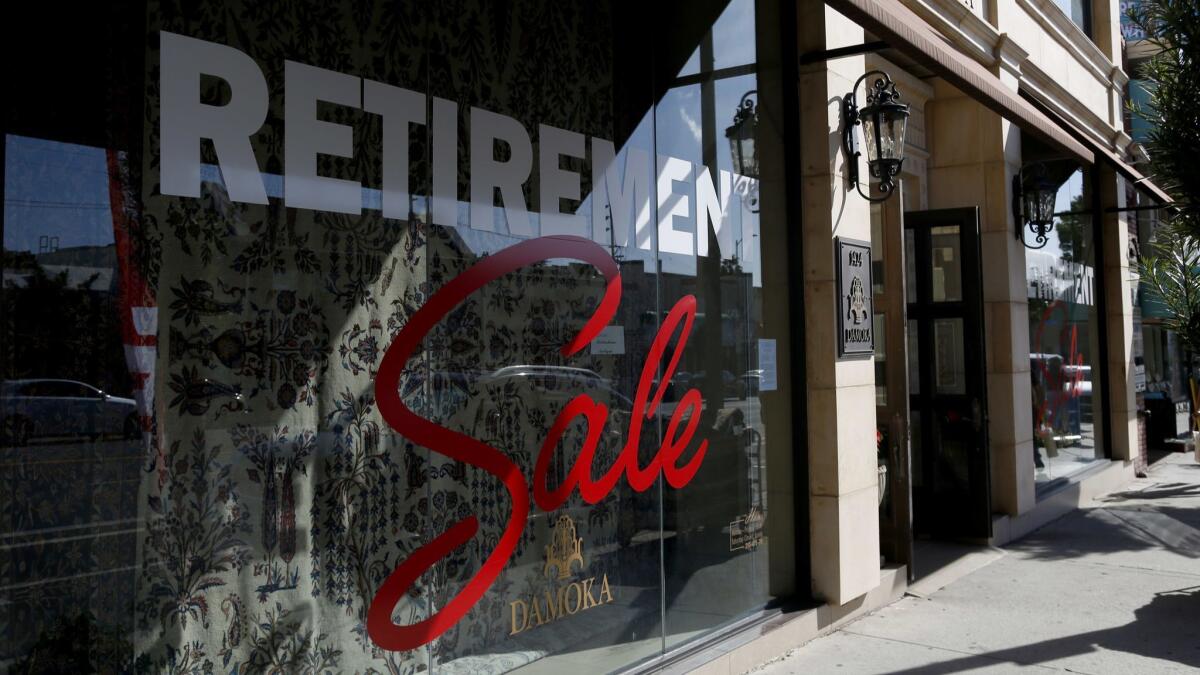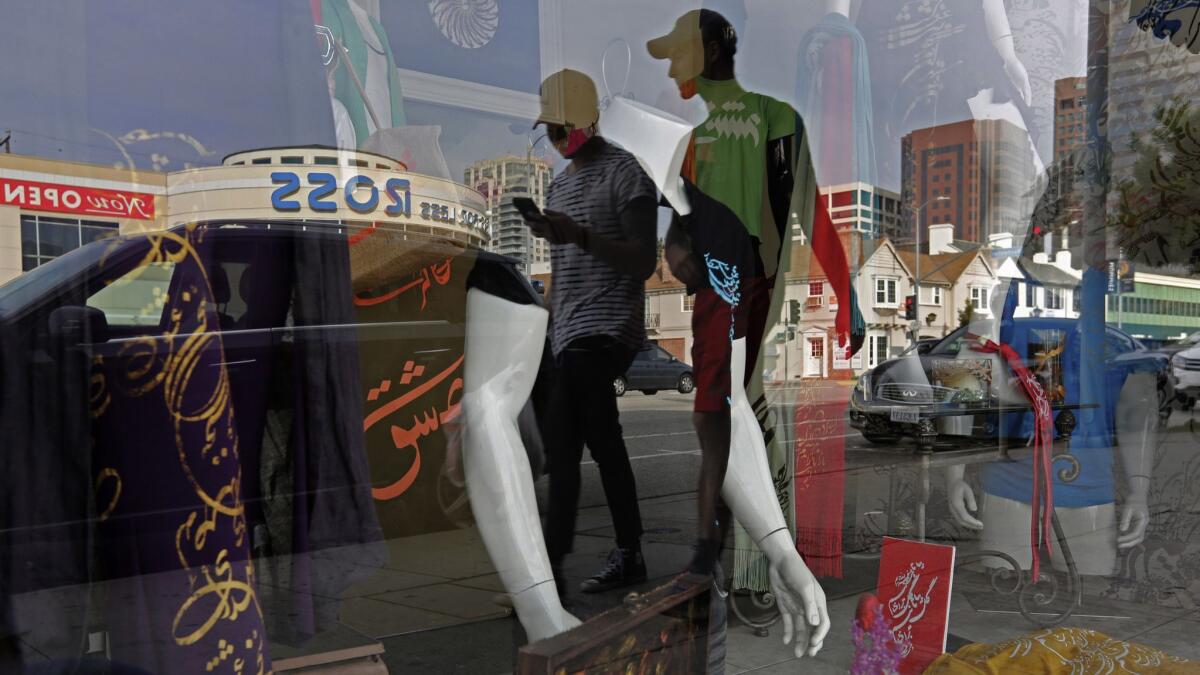With sanctions reimposed, some Iranian American businesses say they’re back at square one

- Share via
Alex Helmi walked through the stacks of Persian rugs in his gallery and admired each bundle piled waist-high on the showroom floor. A sign hanging from the ceiling pained him.
“Historic closing sale,” the white letters read.
For 30 years, Helmi has filled his Westwood shop with pieces of art that link Southern California to the Iranian villagers who weave them thousands of miles away.
The 62-year-old doesn’t want to close Damoka. But after President Trump reimposed an aggressive array of sanctions on Iran in November, Helmi decided he was tired of his business being caught in the middle of a geopolitical battle.
“I’m heartbroken,” Helmi said. “I don’t do this for the money. I do it for the history. Why does culture need to be sanctioned?”
The U.S. placed an embargo on Iranian goods in 2010. When it was lifted in 2015, Iranian American business owners felt a surge of hope and anticipated that the end of the ban would reinvigorate a commercial lifeline that had gone dry. Aside from rugs, merchants looked to import other, lesser-known products such as saffron, caviar and pistachios.
In 2016, Helmi received his first shipment of merchandise from Iran since the U.S. imposed the ban. Among the cargo sat 40 handmade rugs — some antique, some modern. Valued at about $500,000, the shipment would replenish his assortment of older rugs.
Then President Trump withdrew from the landmark nuclear accord. The administration’s new sanctions target major sectors of the Iranian economy, such as energy, shipping, shipbuilding and finance. In all, more than 700 individuals, vessels, aircraft, banks, companies and other entities were put on the U.S. blacklist — 300 more than before.
“I’ve lost my patience,” Helmi said. “I want to get out. I don’t see any hope of getting anywhere.”
The White House has argued that the sanctions will cause such hardships that Iranian authorities will be forced to reopen negotiations, abandon their ballistic missiles and stop bankrolling militant groups across the Middle East.
Adel Tousi, who runs Tousi Rugs with his father and brother in Westwood, said that as soon as they started to feel the effects of sanctions being lifted and began to make moves, “we got hit again.”
“As things started balancing out, we ended up right back where we were,” said Tousi, whose family has been in the Persian rug industry for five generations.
A few months ago, a young manufacturer from Iran visited Tousi’s store, eager to discuss a new relationship. The man had an idea to weave machine-made rugs in Iran and sell them in the U.S. to younger customers who can’t afford the thousands of dollars a handmade carpet costs. Right now, Tousi said, Asian manufacturers have cornered that market.
“I thought it was a really cool idea, a starter rug for a starter home,” he said. “Iran had never done that before, importing machine rugs that were meant to look like the real ones. Now we have no opportunity to bring that.”
Between the Persian rugs his family already had in the shop and more economical Afghan and Pakistani rugs they sell, the store has enough carpets in the market to weather the latest sanctions, Tousi said. But if the ban lasts several years, “it will impact our business moving forward.”

Experts say that before the Obama-era ban, the U.S. accounted for about 20% to 30% of Iran’s carpet exports.
The return of sanctions is simply “going back to the status quo,” said Farhad Alavi, an international trade compliance attorney.
The back-and-forth has created a situation in which Iranians do not have the option to buy things from “back home” the way other ethnic communities do, Alavi said.
“Downstairs from my office, I can buy Japanese Kit Kat, but you can’t buy Iranian khoresh,” he said, referring to Persian stew. “Our Walmart will have products from Lebanon like dolma leaves. We can’t have that unless it’s made in the U.S.”
Those American-made Iranian specialty foods, manufactured by brands such as Sadaf in California, have helped to insulate diaspora businesses from the effects of politics, said Farid Khanlou, owner of Jordan Market in Westwood.
“You can’t say sanctions won’t have an effect, but they won’t have a large one,” Khanlou said in Persian.
Southern California is home to the largest Iranian community outside of Iran. Most of the Iranians who live in Los Angeles have lived here for nearly 40 years, Khanlou said. As a result, fewer people are looking for goods from their homeland.
“Iranians who are here, their tastes have changed. They buy Iranian products like Sadaf because they’re from here,” Khanlou said. “When it comes from Iran, it’s about twice as expensive.”
The main specialty product people ask for is lavashak — Persian fruit leather — which he stocked up on when the embargo was lifted, he said.
There are workarounds for other food, such as pistachios, which are exported from Iran and brought in through Canada, he added.
Helmi, the retiring rug store owner, said he emigrated from Iran decades ago with a mission of spreading his country’s art. Since then, he’s curated thousands of pieces, some of them 200 years old. Many are dyed with natural ingredients such as pomegranate, walnut skins, and acorn cups. They can take a decade or more to weave.
As he sipped tea on the second floor of his showroom, Helmi said he never thought he would close his store. But between the sanctions and his children’s lack of interest in the family business, he sees no other path.
He may repurpose the space for community events, including Persian New Year parties and mixers for younger Iranian Americans, he said.
“I did the best I could,” he said. “Enough is enough. How many times can we pull the yo-yo up and down?”
More to Read
Sign up for Essential California
The most important California stories and recommendations in your inbox every morning.
You may occasionally receive promotional content from the Los Angeles Times.














